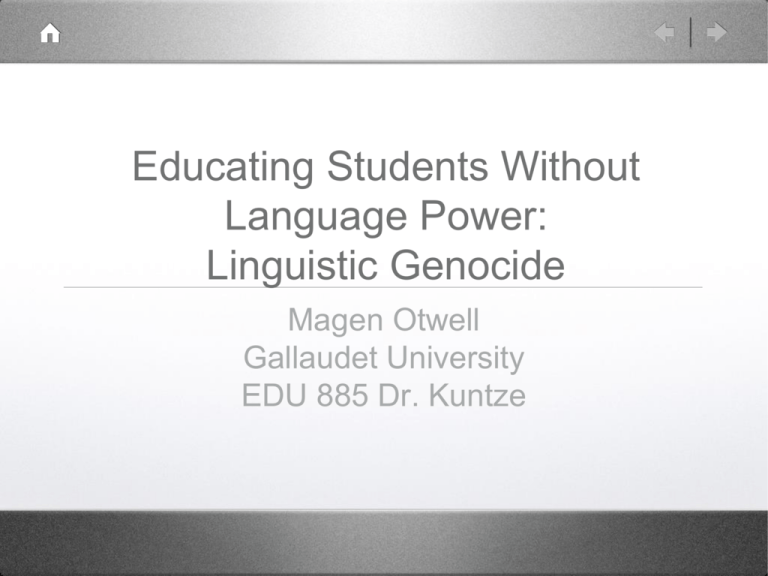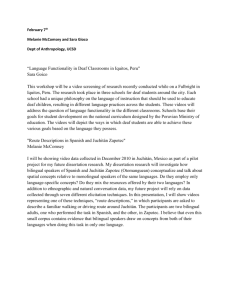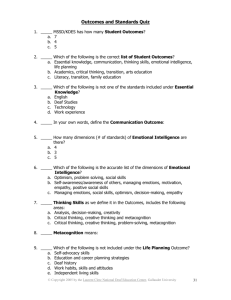Artifact 5
advertisement

Educating Students Without Language Power: Linguistic Genocide Magen Otwell Gallaudet University EDU 885 Dr. Kuntze • Linguistic-minority students’ language[s] should never be sacrificed, since it is the only means through which they make sense of their own experience in the world. • (Donald Macedo, 2006, p. 128) • • • What will be offered in this presentation is the possibility of choosing a different, but valid, perspective of education for Latino deaf students. There is no one explanation of how deaf students should be educated that that is adequate or complete, but it is key not to ignore the significance of languages other than English in the classroom. Examining the current conditions of deaf education and of language use and language instruction assists in understanding Latino deaf students school achievement, or lack thereof. Questioning Language Instruction in Deaf Education • • • Native language (i.e. American Sign Language) and home language (i.e. Spanish) instruction will benefit students more than English-Only language instruction and failure to include Spanish instruction might, under certain circumstance, be considered linguistic genocide. Argument for trilingual or multilingual education At the very least, integrating the students’ languages in the classroom; “for example, during language instruction, introduce words and signs from different languages (Mommy-Mami, DaddyPapi, Garndpa-Abuelito, Grandma-Abuelita)” • (Sass-Lehrer, Gerner de Garcia, and Rovins, 1997, p. 5) • Society has language preferences • Preference is for dominant language English (not ASL or Spanish) • Oppression - Language preferences lead to language exclusion • Linguistic Genocide - affects student achievement • It is subtractive dominant language learning ... that kills other languages...That is a starting point for action for diversity. • (Tove Skutnabb-Kangas, 2000, p. xxxiii) Why the need for trilingual education? • ~30% of Deaf and Hard of Hearing students are Latino. • • (Gallaudet Research Institute, 2011) They may arrive at school with “some abilities in each of three languages, Spanish, English, and sign, yet [they] are viewed primarily as deficient because [they are] not fluent in any of these languages.” • (Gerner de Garcia, Morocco, Mata-Aguilar, n.d., p.8) • Skutnabb-Kangas (2003) supports linguistic human rights, stating that those who have two mother tongues and live in a country where none of them is an official language have the right to become trilingual. • A ‘mother tongue’ fits any of the following criteria: (1) a language learned first, (2) a language an individual/person identifies with, or (3) a language a person chooses to use most. To emphasize the term ‘chooses’ in the last line, is to remind society that forcing English on students in school without the option for Spanish is a choice-less choice. Further, “An individual can have at least two, possibly three mother tongues.” • • (Skutnabb-Kangas, 2008, p. 86) 62% of Latino deaf students have some proficiency in Spanish. • • (Struxness, 2000) Native language skills are typically easily transferred to second and third languages, thus literacy and academic achievement are supported by fostering the languages students bring to school • (Wiley, 2005) • • • • • What about deaf students who don’t know any Spanish? “It is possible to identify with a language that one does not know” (Skutnabb-Kangas, 2008, p. 14). The same holds true for ASL. What about literacy? The word ‘English’ is absent from most definitions of literacy. It’s important to consider what forms of literacy are valued. The more consistent ... home and school cultures are, ..., more successful students will be. • (Nieto & Bode, 2012, p. 262) LINGUICISM • These deficit language views that prioritize one language over another or negatively characterize one’s language abilities (as is often the case with deaf immigrants) is referred to as linguicism. • • (Gerner de Garcia et al, n.d., p.12) When schools for the deaf exhibiting a preference for English language instruction and a marginalization of Spanish language instruction they are practicing linguicism. For these students, Spanish may be eradicated, thus taking linguicism a step further. LINGUISTIC GENOCIDE • Linguistic genocide involves the killing of languages, not people. • • • • • (Skutnabb-Kangas, 2000) Resolution that was adopted by the United Nations General Assembly in 1948, Articles 2b and 2e state: In the present Convention, genocide means any of the following acts… (b) Causing serious bodily or mental harm to members of the group; (e) Forcibly transferring children of the group to another group. • At its most basic level, the term bilingual education refers to the use of two (or more) languages of instruction at some point in a student’s school career. • (Jim Cummins, 2009, p.19) • Latino deaf students who are oral have the option of bilingual (Spanish/English) instruction. • While Latino Deaf signers are not afforded the same luxury. • Example of the hegemony of spoken language. Why not leave it up to the parents to teach them Spanish at home? • • • What if the same question were posed, substituting Spanish with ASL? Linguistic priority- learning English for survival Only 23-29% of families with deaf children ever learn to sign, including deaf families • • (Gallaudet Research Institute, 2011) “[Latino] Deaf children are less likely than white Deaf children to have a sign language used at home. Therefore, they have less opportunities for communication” (Lane et al., 1996, p. 164). Few Spanish speaking families learn to sign due to the fact that they are not fluent in English, the language in which the sign class is offered (Allen, 2002). Funds of Knowledge • Based on language • Moll, Amanti, Neff & Gonzalez (2001) • Come to know the students and their home experiences (including language) for academic benefit Won’t this hinder English? • The fear that bilingual education will not lead to English proficiency and without English proficiency opportunities for success decrease is without warrant • • English fluency does not, in fact, guarantee academic success • • (Macedo, 2006, pp. 128-129) (Adams, Astone, Nunez-Wormack, & Smodlaka, 1994) Successful multilingual environment, in Kenya, where students with disabilities learned three languages with fluency equal to natives • (Candelaria-Greene, 1996, as cited in Cummins, 2000) • When two languages are used in the school to affirm the experiences and culture of the students and communities who speak those languages, this in itself challenges the discourse of superiority and devaluation that characterize social relations between these communities and wider society. • (Cummins, 2000, p. 10) Questions? • References Adams, D., Astone, B., Nunez-Wormack, E., & Smodlaka, I. (1994). Predicting the academic achievement of Puerto Rican and Mexican-American ninth-grade students. The Urban Review, 26(1), 1-14. • Allen, B. M. (2002). ASL-English bilingual classroom: The families’ perspectives. Bilingual Research Journal, 26(1), 1-20. • Cummins, J. (2000). Language, power, and pedagogy: Bilingual children in the crossfire. Buffalo, NY: Multilingual Matters. • • • Cummins, J. (2009). Fundamental Psycholinguistic and Sociological Principles Underlying Educational Success for Linguistic Minority Students. In T. Skutnabb-Kangas, R. Phillipson, A.K. Mohanty, & M. Panda (Eds.), Linguistic Diversity and Language Rights: Social Justice Through Multicultural Education (p. 19-34). New York: Multilingual Matters. Gallaudet Research Institute (2011). Regional and National Summary Report of Data from the 2009-10 Annual Survey of Deaf and Hard of Hearing Children and Youth. Washington, DC: GRI, Gallaudet University. Gerner de Garcia, B., Morocco, C., & Mata-Aguilar, C. (n.d.) The home language and literacy environment of the Latino deaf/hard of hearing child. Adapted from: Literacy for Latino Deaf and Hard of Hearing English Language Learners. Unpublished article. • Hornberger, N. (1989). The continua of biliteracy. Review of Educational Research, 59(3), 271- 296. • Lane, H., Hoffmeister, R., & Bahan, B. (1996). A journey into the deaf world. San Diego, CA: Dawn Sign Press. • Macedo, D. (2006). Literacies of power: What Americans are not allowed to know. Boulder, CO: Westview Press. • Moll, L., Amanti, C., Neff, D. and Gonzalez, N. (2001). Funds of knowledge for teaching: Using a qualitative approach to connect homes and classrooms. Theory Into Practice, XXXI, 2, 132-141. References • • • • • • • • Nieto, S. & Bode, P. (2012). Affirming diversity: The sociopolitical context of multicultural education. 6th edition. Boston : Pearson/Allyn & Bacon. Sass-Lehrer, M., Gerner de Garcia, B., and Rovins, M. (1997). Creating a multicultural school climate for deaf children and their families. Washington, DC: Pre-College National Missions Programs, Gallaudet University. Skutnabb-Kangas, T. (2000). Linguistic genocide in education- or worldwide diversity and human rights? Mahwah, New Jersey: Lawrence Erlbaum Associates, Publishers. Skutnabb-Kangas, T. (2003). Linguistic genocide and the Deaf. Retrieved from http://www.deafzone.ch/file/file_pool/action/download/file_id/1379/ Skutnabb-Kangas, T. (2008). Bilingual education and Sign language as the mother tongue of Deaf children. In Kellett Bidoli, Cynthia J. & Ochse, Elana (eds). English in International Deaf Communication. Bern: Peter Lang, 75- 94. Struxness, K. (2000). School support services for Hispanic Deaf children and families in southern California school settings. In Christensen (Ed.), Deaf plus: A multicultural perspective (pp. 199-220). United States: DawnSignPress. United Nations General Assembly. (1948). Convention of the prevention and punishment of the crime of genocide. Resolution 260 (III). Retrieved from http://www.hrweb.org/legal/genocide.html. Wiley, T.G. (2005). Literacy and language diversity in the United Staes (2nd ed.). Washington, DC: Center for Applied Linguistics.






